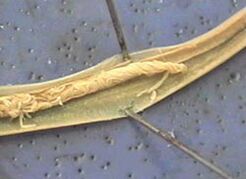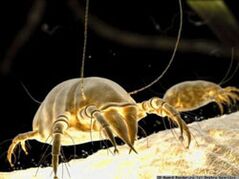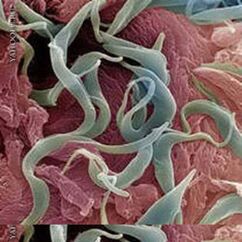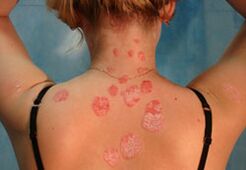Many people who lead a healthy lifestyle have health disorders due to the presence of parasites.Highlight the body (adequate nutrition, physical exercises, hardening procedures) without eliminating the body of the parasites does not give a pronounced positive effect.According to the World Health Organization, helminths are located not only in the gastrointestinal tract, but also in vital organs: brain, heart, lungs, liver, kidneys.Helmins in the processes of their life distinguish special substances: toxins that are strong poisons and allergens.It is the simplest, fungi and helminths that are the trigger mechanism for many chronic diseases: cholecystitis, cholelithiasis, pancreatitis, colitis, diabetes mellitus, bronchial asthma, atopic dermatitis.

Chronic fatigue, irritability and anxiety, hyperactivity in children, anemia, brittle nails and hair, problematic skin, headaches, appetite disorders, immunity reduction: these can be the signs of current disease.With a long stay of parasites in the human body, the immune system suffers a lot.In the process of constant struggle with foreign antibodies, it is about exhaustion, that is, the development of secondary immunodeficiency.Parasites disease leads to hypovitaminosis, microelement exhaustion: potassium, copper, manganese, selenium, zinc, magnesium, silicon;The violation of hematopoiesis, hormonal insufficiency, vascular permeability, body cancer protection suffers is violated.
During millennia, people, mainly plant foods, received natural antimicrobial, antiparasitic and antiviral active substances.A decrease in the consumption of wild plants, fruits, berries, replacement of their vegetables and fruits, thermal and industrial treatment led to a decrease in the consumption of natural volatile and antibiotics.As a result, a person became easy prey for many microorganisms.The intensive development of the pharmaceutical industry produced by antibiotics led to a decrease in immunity.
Determination of parasites

Parasites (from the Greek. Parasitos - a superposition, a parasite) - lower organisms of plants and animals that live outside or inside another body (owner) and eat at their expense.The parasites arose in the process of historical development of organisms in freely living ways.Its adaptation to certain living conditions implied the simplification of its organization, the development of special fixing organs, a greater development of the genital organs, breathing, which makes it possible to exist in an impassive environment.Parasites include many helminths, fungi, viruses, protozoa, worms, crustaceans, spider -shaped insects.Parasites owners can be bacteria, simpler, plants, animals and humans.The parasites suffer a complex development cycle: sometimes they need a change of 2-3 owners whose body is intermediate (the helminths pass the larval stages) or final (the helminths become ripe, invasive).Parasites cause the weakening and exhaustion of the guest's body, cause a series of diseases.
Helminants can parasitize in all the tissues and organs of a person, but the most common place of their location is the food tract.Toro and had a pork, a wide tape are fixed in the upper thin intestine, also parasite to Ascaris.The Dwarf Tabbell is located mainly in the lower third of the small intestine, the Vlasov, in the large intestine, opistorchis, in the bile passages of the liver and the pancreas ducts, the pineapples, in the lower parts of the thin ones and in all parts of the large intestine.Therefore, the distribution of different types of helminths throughout the digestive tract in search of the most favorable living conditions provides them with an individual survival and creates the conditions for the development of various types in a person's body.
Classification
By distribution:
- Ubiquette - Know everywhere.
- Tropical: distributed in tropical climatic zones.
According to the biological and epidemiological characteristics: Geohelmintos, a disease in which the Helmints develop for the first time in the human body, and then in a non -living substrate, more frequently in the soil.Biohelmintos are a disease in which a biological cycle of development of the helminto necessarily takes place in the body of other living beings, except for a person.Distinguish between the final owners, in the body from which the helminths develop to the sexually mature stage, as well as the intermediates, where the parasite is in the stage of the larva or its reproduction is not sexually.A person is more often the final host, less frequently, intermediate.Helmintiasis of the connection is a disease in which parasites are distinguished from the human body with mature or almost mature, as a result of which another person's infection is possible or their own rehiesta.
Depending on the location of the parasite in the body: educational: living in the intestinal cavity and other cavities of a person (for example, ascárides, tape) and tissue that lives in the tissues.

In the place of stay in the owner:
- External (mosquitoes, blinds, leeches, lice).
- Internal (helminthiasis):
- Round worms (nematodes - ascárides, Vlasov, Lombrices pins, Stchloids);
- Flat worms:
- Trematodes (cats - cat bickelter, schistosomas);
- Cestodes (tape worms - bull and pork, dwarf tabell, wide tape, echinococcus).
- Bacteriosis (Staphylococcus, Streptococcus).
- Protosis (amoebas, lamblia, trichomonas, often the owners of the chlamydia and AIDS virus).
- Mycosses (fungal diseases) -for example, Candida.
How parasites adapt
- a long life expectancy (Helmints live in the body for years, and sometimes as much as the owner of the parasite);
- The ability to suppress or modify the immune response of the guest's body (a state of immunodeficiency arises, conditions for the penetration of pathogens from the outside are created, as well as to revive the internal foci of the infection);
- Many types of helminths, entering the digestive tract, distinguish anti -envimas, which saves them from death;The digestion process is disturbed, toxic-allergic allergic reactions are different in gravity: urticaria, bronchial asthma, atopic dermatitis;
- Development stage (egg, larva, change of owners);
- the capacity of eggs for years to persist in the external environment;
- The sexual reproduction in which genetic information is exchanging, and this is the highest stage of development, which leads to an increase in the heterogeneous population, that is, the parasites become less vulnerable;
- The absence of immunoprophylaxis methods, since the immune response is weak and unstable;
- Helminth generalized, many habitats (water, soil, air, plants and animals).
How parasites enter the body

It can be infected not only through dirty hands.Animal hair is a worker of worms (Ascaride), Lamblia.Lombic eggs that have fallen from wool remain viability for up to 6 months and through dust, toys, carpets, underwear and bedding and hands fall into the food tract.The dog through wet breathing disperses the eggs at a distance of 5 meters (cat - up to 3 meters).Dog fleas also tolerate worm eggs.Askarid eggs enter the body through poorly washed vegetables, fruits, berries, vegetables, dirty hands and also extend to flies.And barbecue or cooking homemade butter is the path of infection with trricinelosis;Badly salted fish, caviar: opistorchiasis and wide tape.
So, there are several ways to enter the body:
- food food (through infected foods, water, dirty hands);
- House-Household (through household items, members of the infected family, pets);
- through blood insects;
- Active (in which the larva penetrates through the skin or mucous membranes during contact with the infected soil, when bathing in open deposits).
Prevention
Here are some rules that must be followed to avoid the penetration of parasites in the body:
- It is not recommended to drink water from natural sources and in an unknown area.
- You can't eat vegetables and fruits without washing.
- It is advisable to be careful with mosquitoes, ticks and other blood insects that can be carriers of parasites.It is necessary to use special means of protection against them, and in places where there are many of them, wear pants and shirts with a long sleeve.
- Before a trip to some countries, it is necessary to get vaccinated by typhoid fever, plague, tropical fever and other infectious diseases.When you go to the places where the malaria mosquito is located, you must take anti -mall tablets.Gathering on a long trip, where ticks can be, it is important to vaccinate tick -transmitted encephalitis.
- Do not allow children to hug and kiss dogs, cats and other pets. Take care of the health of pets: Tomalas deworming courses.
- Follow the rules of personal hygiene, keep the house cleaning.
- Perform periodic preventive antiparasitic courses for the whole family.
Children and parasitic invasions

The most vulnerable to the effects of parasites are children.They are infected with various types of parasites through dirty hands, sand, earth and water.Sometimes, child infection can occur in intrauterine, since simpler larvae, bacteria, viruses, candida and helminths can penetrate the fetus through the placenta with blood flow, as well as during birth through the birth channel.Due to the expansion of their motor activity, at the age of 1.5 to 3 years, children can get infected at home, on a walk, in the kindergarten when you contact contaminated objects (street shoes, floor, toys, common areas), on the street (playing in the sand box or on the floor), as well as in contacts with animals (vagrants or made on the street).The high probability of parasite invasions is observed with non -complement with hygiene rules (unwashing hands, eating unwashed vegetables and fruits, eating raw water from natural ponds and swimming in them).Only worms eggs and the dwarf were transmitted directly from person to person.The eggs of other helminths for maturation must necessarily enter the body of an intermediate host or an adequate environment: soil or water.At the age of 1.5-3, the infection of children with helminths can reach 80%.
More than 90% of all helmi -meterous diseases in children are caused by intestinal nematodes that parasitize in the light of the intestines (Ascaris, Pin worms), parasitating nematodes in the intestinal wall or other organs (ankyostoma, a non -cycinela and intestinal uctuma) are less common.In children, subject to elementary hygiene (improper meat or raw fish or insufficiently treated, vegetables and unwashed fruits, water without fucked of natural deposits), practically there are no worms (trematodes) and tape helminths (cestodes).
How can a child infected?
The infection is carried out when egg larvae enter the body.Eggs enter the environment with stool of infected people and animals.They have microscopic dimensions, are very resistant to various influences and can maintain vitality for a long time outside the body (on the ground, on the surface of objects or products, in linen folds, in the skin).Once in the child's oral cavity, worm eggs pass, partially destroying, through the acidic, aggressive stomach and activated in the intestines, where the conditions for the development of adults of eggs are more favorable.Children of preschool and preschool age are especially susceptible to helminical invasions, since they still have imperfect barriers of the gastrointestinal tract.
Measures for the prevention of helminthiasis in children: for all family members to comply with hygiene rules, try to avoid close contact of the child and personal belongings with pets;In the street it is important to ensure that the child does not select several objects;avoid contact with animals;It is important to instill the child personal hygiene skills (wash your hands with soap after the street and visit the toilet);It is advisable to perform wet cleaning periodically at home, wash with soap toys, especially in the presence of pets, as well as toys brought to walk to the house;In vacuum, carpets, upholstered furniture and upholstered toys;Do not give the child vegetables and unwashed fruits, not thermally sufficiently without processing meat and fish, raw water of natural deposits.
Signs of helminical invasion in children

Most of the time, a child has to guess on the helmi -invasion for indirect signs.The Probability of Helminthic Invasion is very high If the Child has suchConstipation), Frequent Tidimony Or Dizziness, Pallor and Pallor, Pallor and Pale Sineva Under the Eyes, Increased Arutitability of the Child in the capricos without cause, poor asleep and bad night dream, accompanied by screaming, awakening, "restlessness", grinding teeth, itching in the perineum.Often, the parasites lead to the allergy of the body, the skin reactions appear in the form of atopic dermatitis (as a rule, it is stubborn, which is difficult for symptomatic therapy).If worms are in a child or one of the family members, it is necessary to treat the whole family to avoid the formation of the infection approach.In this situation, it is important to strengthen hygienic measures, in particular, boil and iron on both sides and personal underwear.


























